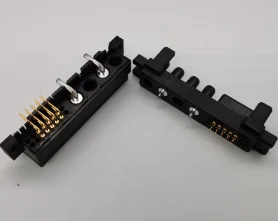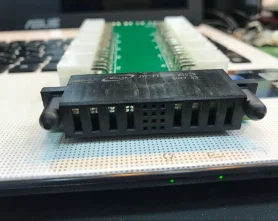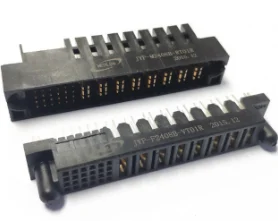MedlonUploaded:2024-02-27Browse:2552

At our company, we specialize in providing top-quality power connectors to keep all of your devices running smoothly. Our products are designed with reliability and durability in mind, ensuring that your devices maintain a consistent and stable power supply. With a wide range of options to choose from, including connectors for laptops, smartphones, and other electronic devices, we have the perfect solution for all of your power needs. Our connectors are made from high-quality materials and undergo rigorous testing to ensure their performance and safety. Trust us to provide you with the best power connectors on the market and keep your devices running smoothly.
Powering up your devices has never been easier with our top-of-the-line power connector solutions. We understand the frustration of constantly having to switch out cables and adapters just to keep your devices charged. That's why we have curated a collection of the best power connectors, ensuring compatibility with all your devices. Whether you're at home, in the office, or on the go, our connectors are designed to provide fast and efficient charging so you can always stay connected. Don't let a dying battery slow you down. Power up with our reliable and convenient power connector solutions today.

1.How do I identify the polarity of a power connector?
1. Check the label or manual: The easiest way to identify the polarity of a power connector is to check the label or manual that came with the device. It should clearly state which pin is positive (+) and which is negative (-). 2. Look for markings on the connector: Some power connectors may have markings on them to indicate the polarity. The positive pin may have a plus sign (+) or a red color, while the negative pin may have a minus sign (-) or a black color. 3. Use a multimeter: If there are no markings on the connector, you can use a multimeter to determine the polarity. Set the multimeter to measure DC voltage and touch the positive probe to one pin of the connector and the negative probe to the other pin. If the multimeter reads a positive voltage, then the pin you touched with the positive probe is the positive pin. If it reads a negative voltage, then the pin you touched with the negative probe is the positive pin. 4. Check the device: You can also check the device itself to determine the polarity of the power connector. Look for any markings or labels near the power input that indicate the polarity. You can also refer to the device's manual or contact the manufacturer for assistance. 5. Use a polarity tester: If you have a polarity tester, you can use it to determine the polarity of the power connector. Simply plug the tester into the power connector and it will indicate which pin is positive and which is negative. Note: It is important to identify the polarity of a power connector correctly before connecting it to a device. Reversing the polarity can damage the device or cause it to malfunction.
2.What is the difference between a power connector and an electrical socket?
A power connector is a device used to connect an electronic device to a power source, such as a wall outlet or power strip. It typically has two or three prongs that fit into corresponding slots in the socket. An electrical socket, also known as an outlet or receptacle, is a fixed device installed in a wall or power strip that provides a connection point for a power connector. It has slots or holes that match the prongs of a power connector and allows electricity to flow from the power source to the connected device. In summary, a power connector is the plug that goes into the socket, while the electrical socket is the fixed outlet that provides the connection point for the power connector.
3.How do I troubleshoot a loose power connector?
1. Check the power cord: The first step is to check the power cord itself. Make sure it is not damaged or frayed in any way. If it is, replace it with a new one. 2. Check the power outlet: Sometimes, the problem may not be with the power connector, but with the power outlet. Make sure the outlet is working properly by plugging in another device. 3. Tighten the connector: If the connector is loose, try tightening it with your fingers. If it still feels loose, use a small screwdriver to tighten the screws on the connector. 4. Clean the connector: Over time, dust and debris can accumulate in the power connector, causing it to become loose. Use a can of compressed air to clean out any dirt or debris that may be stuck inside. 5. Check the connection on the device: If the power connector is attached to a device, make sure the connection is secure. If it is loose, try tightening it or using a different connector. 6. Use a different power cord: If the power cord is the issue, try using a different one to see if it makes a difference. If the new cord works, then the old one may need to be replaced. 7. Consider using a stabilizer: If the power connector is constantly coming loose, you may want to consider using a stabilizer. This is a small device that attaches to the power cord and helps keep it in place. 8. Seek professional help: If none of the above steps work, it may be best to seek professional help. A technician can diagnose the issue and provide a solution, such as replacing the power connector or the device itself.

4.How do I clean and maintain my power connectors to ensure proper functioning?
1. Disconnect the power supply: Before cleaning or maintaining the power connectors, make sure to disconnect the power supply from the device or outlet to avoid any electrical shock. 2. Use compressed air: Use a can of compressed air to blow away any dust or debris from the power connectors. Hold the can upright and use short bursts of air to avoid any moisture buildup. 3. Wipe with a cloth: Use a soft, lint-free cloth to wipe the power connectors. You can also dampen the cloth with a small amount of isopropyl alcohol for better cleaning. 4. Check for corrosion: Inspect the connectors for any signs of corrosion. If you find any, use a small amount of vinegar or lemon juice on a cotton swab to gently clean the affected area. Make sure to dry the connectors thoroughly before reconnecting the power supply. 5. Tighten loose connections: Over time, the power connectors may become loose, which can cause power interruptions. Use a screwdriver to tighten any loose connections to ensure a secure and stable connection. 6. Use dielectric grease: If you live in a humid or coastal area, it is recommended to use dielectric grease on the power connectors. This will help prevent corrosion and ensure a smooth flow of electricity. 7. Avoid overloading: Make sure not to overload the power connectors with too many devices. This can cause overheating and damage the connectors. Use a surge protector to distribute the power evenly and protect the connectors from power surges. 8. Regular maintenance: It is important to regularly clean and maintain the power connectors to ensure proper functioning. Make it a part of your routine maintenance schedule to avoid any potential issues. 9. Replace damaged connectors: If you notice any damage or wear and tear on the power connectors, it is best to replace them with new ones. This will ensure a safe and reliable power connection. 10. Consult a professional: If you are unsure about how to clean or maintain the power connectors, it is best to consult a professional. They can provide you with proper guidance and ensure that the connectors are in good working condition.
5.Can a power surge damage a power connector?
Yes, a power surge can potentially damage a power connector. A power surge is a sudden increase in the electrical current flowing through a circuit, which can cause damage to electronic devices and their components. If the power surge is strong enough, it can overload and damage the power connector, causing it to fail or malfunction. It is important to use surge protectors to protect electronic devices from power surges.
6.How do I ensure proper grounding for my power connector?
1. Use a three-pronged power cord: The most important step in ensuring proper grounding for your power connector is to use a three-pronged power cord. This type of cord has a third prong, known as the ground pin, which is responsible for connecting the device to the ground. 2. Check the outlet: Make sure the outlet you are using is properly grounded. You can do this by using a circuit tester or by plugging in a device and checking for a proper connection. 3. Use a surge protector: A surge protector not only protects your devices from power surges, but it also provides an additional layer of grounding. Make sure to use a surge protector that has a built-in ground indicator light to ensure proper grounding. 4. Avoid using extension cords: If possible, avoid using extension cords as they can interfere with the grounding process. If you must use an extension cord, make sure it is properly grounded and in good condition. 5. Keep the power cord away from water: Water is a good conductor of electricity, so it is important to keep your power cord away from any sources of water to prevent the risk of electric shock. 6. Use a ground loop isolator: If you are experiencing humming or buzzing noises from your audio or video equipment, it may be due to a ground loop. In this case, using a ground loop isolator can help eliminate the noise and improve grounding. 7. Consult a professional: If you are unsure about the grounding of your power connector, it is best to consult a professional electrician. They can inspect your wiring and make any necessary adjustments to ensure proper grounding.

7.Can I use adaptors to convert one type of power connector to another?
Yes, you can use adaptors to convert one type of power connector to another. Adaptors are designed to allow different types of power connectors to be connected to each other, making it possible to use devices with different power requirements. However, it is important to make sure that the adaptor is compatible with both the power source and the device you are connecting it to, as using an incompatible adaptor can cause damage to your devices. It is also important to use adaptors from reputable manufacturers to ensure safety and proper functioning.
8.How do you properly connect a power connector to a device?
1. Identify the type of power connector: Before connecting the power connector, make sure you have the correct type of connector for your device. Common types of power connectors include USB, AC/DC adapters, and barrel connectors. 2. Turn off the device: Before connecting the power connector, it is important to turn off the device to avoid any potential damage. 3. Locate the power input: The power input is usually located on the back or side of the device. It is usually labeled with a symbol or the word power."